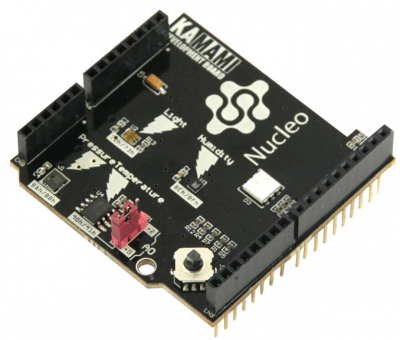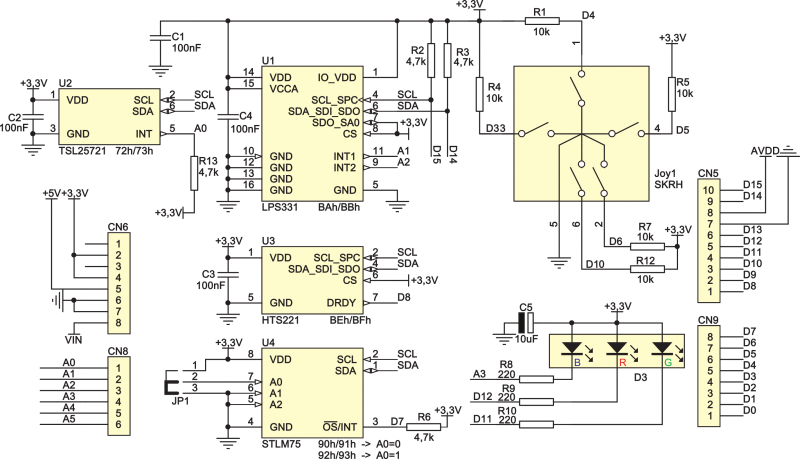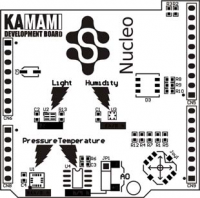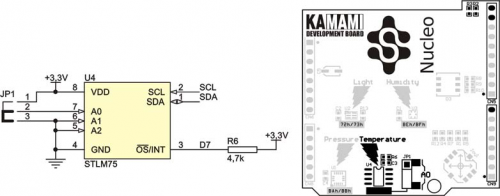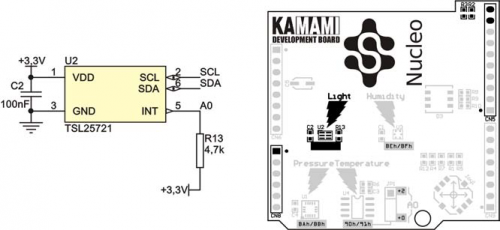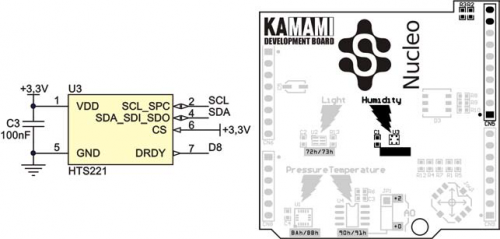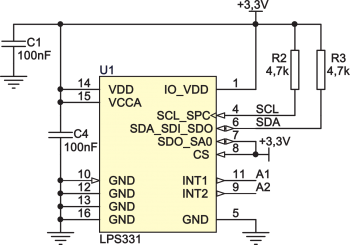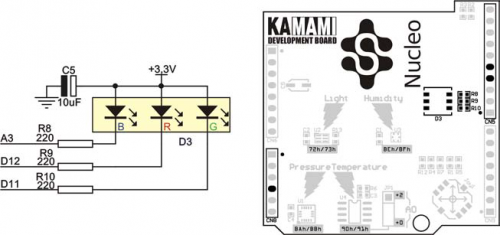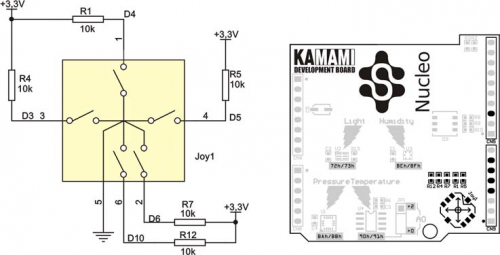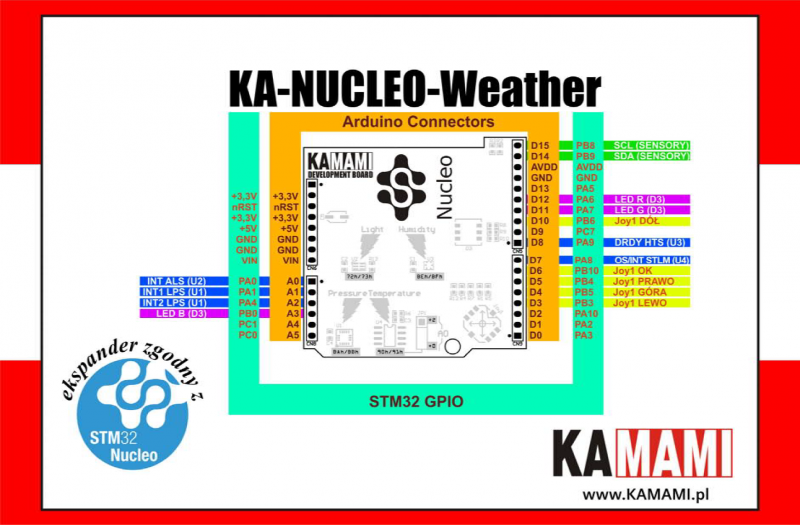Difference between revisions of "KA-Nucleo-Weather (PL)"
Anna Kubacka (talk | contribs) (Utworzono nową stronę "__jzpdf__ ====== Description ====== [https://kamami.pl/kamod-kamami/333318-ka-nucleo-weather-ekspander-shield-z-sensorami-srodowiskowymi-cisnienia-wilgotnosci-temperatu...") |
Anna Kubacka (talk | contribs) |
||
| (5 intermediate revisions by 3 users not shown) | |||
| Line 1: | Line 1: | ||
__jzpdf__ | __jzpdf__ | ||
| − | ====== | + | ====== Opis ====== |
| − | [https://kamami.pl/kamod-kamami/333318-ka-nucleo-weather-ekspander-shield-z-sensorami-srodowiskowymi-cisnienia-wilgotnosci-temperatury-natezenia-swiatla.html KA-Nucleo-Weather] | + | [https://kamami.pl/kamod-kamami/333318-ka-nucleo-weather-ekspander-shield-z-sensorami-srodowiskowymi-cisnienia-wilgotnosci-temperatury-natezenia-swiatla.html KA-Nucleo-Weather] to ekspander funkcjonalny dla NUCLEO i Arduino z zestawem sensorów środowiskowych: ciśnienia, wilgotności, temperatury i natężenia światła oraz 5-pozycyjnym joystickiem i LED RGB. |
<center> | <center> | ||
| − | [[ | + | [[File:KA-Nucleo-Weather_modul.png|none|400px|thumb|center]] |
</center> | </center> | ||
| + | |||
| + | ===== Podstawowe cechy i parametry ===== | ||
| + | *Zgodność z systemami NUCLEO i Arduino | ||
| + | * Wbudowany sensor ciśnienia MEMS (LPS331): | ||
| + | **Zakres pomiarowy 260 do 1260 mbar | ||
| + | **Częstotliwość pomiarów (ODR) 1 Hz do 25 Hz | ||
| + | **Rozdzielczość ADC 24 bity | ||
| + | **Interfejs SPI/I2C (użyty I2C) | ||
| + | *Wbudowany sensor wilgotności MEMS (HTS221) | ||
| + | **Zakres pomiarowy 0 to 100% (wilgotność względna) | ||
| + | **Częstotliwość pomiarów (ODR) 1 do 12,5 Hz | ||
| + | **Rozdzielczość ADC 16 bitów | ||
| + | **Interfejs SPI/I2C (użyty I2C) | ||
| + | *Wbudowany cyfrowy sensor temperatury (STLM75): | ||
| + | **Zakres pomiarowy –55°C do +125°C | ||
| + | **Czas konwersji ADC <150 ms | ||
| + | **Zintegrowany programowany termostat | ||
| + | **Rozdzielczość ADC 9 bitów | ||
| + | **Interfejs SMbus/I2C | ||
| + | *Wbudowany cyfrowy sensor natężenia oświetlenia ALS (TSL25721): | ||
| + | **Charakterystyka czułości zbliżona od oka ludzkiego | ||
| + | **Zintegrowane wzmacniacze analogowe o programowanym wzmocnieniu | ||
| + | **Dwa kanały pomiarowe | ||
| + | **Zintegrowany programowany komparator | ||
| + | **Dynamika pomiaru 45000000:1 | ||
| + | **Maksymalne natężenie światła 60000 lux | ||
| + | **Rozdzielczość ADC 16 bitów | ||
| + | *Wbudowana LED RGB | ||
| + | *Wbudowany joystick 5-stykowy | ||
| + | *Przedłużone złącza szpilkowe | ||
| − | ===== | + | ===== Wyposażenie standardowe ===== |
| − | |||
| − | |||
| − | |||
| − | |||
| − | |||
| − | |||
| − | |||
| − | |||
| − | |||
| − | |||
| − | |||
| − | |||
| − | |||
| − | |||
| − | |||
| − | |||
| − | |||
| − | |||
| − | |||
| − | |||
| − | |||
| − | |||
| − | |||
| − | |||
| − | |||
| − | |||
| − | |||
| − | |||
| − | |||
| − | |||
| − | |||
<center> | <center> | ||
{| class="wikitable" style="width: 1000px;" | {| class="wikitable" style="width: 1000px;" | ||
|- | |- | ||
| − | ! style="text-align: center;"| | + | ! style="text-align: center;"|Kod |
| − | ! style="text-align: center;"| | + | ! style="text-align: center;"|Opis |
|- | |- | ||
| style="text-align: center;"|<b>KA-Nucleo-Weather</b> | | style="text-align: center;"|<b>KA-Nucleo-Weather</b> | ||
| style="text-align: center;"| | | style="text-align: center;"| | ||
| − | * | + | *Zmontowany i uruchomiony moduł |
|} | |} | ||
</center> | </center> | ||
| − | ===== | + | ===== Schemat elektryczny ===== |
<center> | <center> | ||
| − | [[ | + | [[File:KA-Nucleo-Weather_schemat.png|none|800px|thumb|center]] |
</center> | </center> | ||
| − | ===== | + | ===== Widok płytki ===== |
<br> | <br> | ||
<center> | <center> | ||
| − | [[ | + | [[File:KA-Nucleo-Weather_obrys_PCB.png|none|200px|thumb|center]] |
</center> | </center> | ||
| − | ===== | + | ===== Czujnik temperatury ===== |
| − | + | W ekspanderze zastosowano półprzewodnikowy czujnik temperatury STLM75 z wyjściem cyfrowym. Magistralę | |
| + | komunikacyjna czujnika temperatury dołączono do wspólnej (dla wszystkich sensorów) magistrali I2C. Linie komunikacyjne | ||
| + | magistrali I2C są podciągnięte do plusa zasilania za pomocą rezystorów 4,7kΩ. | ||
| + | Sposób dołączenia sensora temperatury do mikrokontrolera pokazano na schemacie. | ||
| + | Wyjście czujnika temperatury dołączono do linii A2, która spełnia rolę kanału wejściowego ADC_IN4 (linia GPIO PA4 w STM32). | ||
<center> | <center> | ||
| − | [[ | + | [[File:KA-Nucleo-Weather_obrys_schemat_temp_sens.png|none|500px|thumb|center]] |
</center> | </center> | ||
<br> | <br> | ||
| Line 72: | Line 75: | ||
{| class="wikitable" style="width: 1000px;" | {| class="wikitable" style="width: 1000px;" | ||
|- | |- | ||
| − | ! style="text-align: center;"| | + | ! style="text-align: center;"|Linia STLM75 |
| − | ! style="text-align: center;"| | + | ! style="text-align: center;"|Nazwa linii |
| − | ! style="text-align: center;"|GPIO | + | ! style="text-align: center;"|GPIO w STM32 |
| − | ! style="text-align: center;"|STM32 | + | ! style="text-align: center;"|Interfejs STM32 |
| − | ! style="text-align: center;"| | + | ! style="text-align: center;"|Uwagi |
|- | |- | ||
| Line 83: | Line 86: | ||
| style="text-align: center;"|PB8 | | style="text-align: center;"|PB8 | ||
| rowspan="2" style="text-align: center;"|I2C1 | | rowspan="2" style="text-align: center;"|I2C1 | ||
| − | | rowspan="3" style="text-align: center;"| | + | | rowspan="3" style="text-align: center;"|Linie podciągnięte do plusa zasilania rezystorami 4,7kΩ |
|- | |- | ||
| Line 98: | Line 101: | ||
|} | |} | ||
<br> | <br> | ||
| − | + | Zwora JP1 umożliwia wybranie adresu bazowego układu STLM75 zgodnie z tabelą poniżej: | |
{| class="wikitable" style="width: 500px;" | {| class="wikitable" style="width: 500px;" | ||
|- | |- | ||
| − | ! style="text-align: center;"| | + | ! style="text-align: center;"|Zwarte styki JP1 |
! style="text-align: center;"|A0 | ! style="text-align: center;"|A0 | ||
| − | ! style="text-align: center;"|I2C | + | ! style="text-align: center;"|Adres bazowy I2C |
|- | |- | ||
| style="text-align: center;"|1-2 | | style="text-align: center;"|1-2 | ||
| Line 116: | Line 119: | ||
</center> | </center> | ||
| − | ===== | + | ===== Czujnik oświetlenia (ALS) ===== |
| − | + | Ekspander wyposażono w cyfrowy czujnik natężenia światła w otoczeniu TSL25721, wyposażony w interfejs komunikacyjny | |
| + | I2C. | ||
| + | Magistralę komunikacyjną tego czujnika dołączono do wspólnej (dla wszystkich sensorów) magistrali I2C. Linie | ||
| + | komunikacyjne magistrali I2C są podciągnięte do plusa zasilania za pomocą rezystorów 4,7kΩ. | ||
| + | Sposób dołączenia sensora TSL25721 do mikrokontrolera pokazano na schemacie. | ||
<center> | <center> | ||
| − | [[ | + | [[File:KA-Nucleo-Weather_obrys_schemat_ALS_sens.png|none|500px|thumb|center]] |
</center> | </center> | ||
<br> | <br> | ||
| Line 126: | Line 133: | ||
{| class="wikitable" style="width: 1000px;" | {| class="wikitable" style="width: 1000px;" | ||
|- | |- | ||
| − | ! style="text-align: center;"| | + | ! style="text-align: center;"|Linia TSL25721 |
| − | ! style="text-align: center;"| | + | ! style="text-align: center;"|Nazwa linii |
| − | ! style="text-align: center;"|GPIO | + | ! style="text-align: center;"|GPIO w STM32 |
| − | ! style="text-align: center;"|STM32 | + | ! style="text-align: center;"|Interfejs STM32 |
| − | ! style="text-align: center;"| | + | ! style="text-align: center;"|Uwagi |
|- | |- | ||
| Line 137: | Line 144: | ||
| style="text-align: center;"|PB8 | | style="text-align: center;"|PB8 | ||
| rowspan="2" style="text-align: center;"|I2C1 | | rowspan="2" style="text-align: center;"|I2C1 | ||
| − | | rowspan="2" style="text-align: center;"| | + | | rowspan="2" style="text-align: center;"|Linie podciągnięte do plusa zasilania rezystorami 4,7kΩ |
|- | |- | ||
| Line 154: | Line 161: | ||
</center> | </center> | ||
<br> | <br> | ||
| − | TSL25721 | + | Sensor TSL25721 jest ulokowany na magistrali I2C pod adresami bazowymi 72h/73h. |
| − | ===== | + | ===== Czujnik wilgotności ===== |
| − | + | Ekspander wyposażono w cyfrowy czujnik wilgotności HTS221, wyposażony w interfejs komunikacyjny I2C. | |
| + | Magistralę komunikacyjną tego czujnika dołączono do wspólnej (dla wszystkich sensorów) magistrali I2C. Linie | ||
| + | komunikacyjne magistrali I2C są podciągnięte do plusa zasilania za pomocą rezystorów 4,7kΩ. | ||
| + | Sposób dołączenia sensora HTS221 do mikrokontrolera pokazano na schemacie. | ||
<br> | <br> | ||
<center> | <center> | ||
| − | [[ | + | [[File:KA-Nucleo-Weather_obrys_schemat_humi_sens.png|none|500px|thumb|center]] |
</center> | </center> | ||
<br> | <br> | ||
| Line 166: | Line 176: | ||
{| class="wikitable" style="width: 1000px;" | {| class="wikitable" style="width: 1000px;" | ||
|- | |- | ||
| − | ! style="text-align: center;"| | + | ! style="text-align: center;"|Linia HTS221 |
| − | ! style="text-align: center;"| | + | ! style="text-align: center;"|Nazwa linii |
| − | ! style="text-align: center;"|GPIO | + | ! style="text-align: center;"|GPIO w STM32 |
| − | ! style="text-align: center;"|STM32 | + | ! style="text-align: center;"|Interfejs STM32 |
| − | ! style="text-align: center;"| | + | ! style="text-align: center;"|Uwagi |
|- | |- | ||
| Line 177: | Line 187: | ||
| style="text-align: center;"|PB8 | | style="text-align: center;"|PB8 | ||
| rowspan="2" style="text-align: center;"|I2C1 | | rowspan="2" style="text-align: center;"|I2C1 | ||
| − | | rowspan="2" style="text-align: center;"| | + | | rowspan="2" style="text-align: center;"|Linie podciągnięte do plusa zasilania rezystorami 4,7kΩ |
|- | |- | ||
| Line 194: | Line 204: | ||
</center> | </center> | ||
<br> | <br> | ||
| − | HTS221 | + | Sensor HTS221 jest ulokowany na magistrali I2C pod adresami bazowymi BEh/BFh. |
| − | ===== | + | ===== Czujnik ciśnienia ===== |
| − | + | Ekspander wyposażono w cyfrowy czujnik ciśnienia atmosferycznego LPS331, wykorzystujący interfejs komunikacyjny | |
| + | I2C. | ||
| + | Magistralę komunikacyjną tego czujnika dołączono do wspólnej (dla wszystkich sensorów) magistrali I2C. Linie | ||
| + | komunikacyjne magistrali I2C są podciągnięte do plusa zasilania za pomocą rezystorów 4,7kΩ. | ||
| + | Wyjścia przerwań (INT1 i INT2) w czujniku LPS331 mogą pracować w trybie push-pull i nie wymagają podciągania | ||
| + | do plusa zasilania. | ||
| + | Sposób dołączenia sensora LPS331 do mikrokontrolera pokazano na schemacie. | ||
<center> | <center> | ||
| − | [[ | + | [[File:KA-Nucleo-Weather_schemat_press_sens.png|none|350px|thumb|center]] |
</center> | </center> | ||
<br> | <br> | ||
| Line 206: | Line 222: | ||
{| class="wikitable" style="width: 1000px;" | {| class="wikitable" style="width: 1000px;" | ||
|- | |- | ||
| − | ! style="text-align: center;"| | + | ! style="text-align: center;"|Linia LPS331 |
| − | ! style="text-align: center;"| | + | ! style="text-align: center;"|Nazwa linii |
| − | ! style="text-align: center;"|GPIO | + | ! style="text-align: center;"|GPIO w STM32 |
| − | ! style="text-align: center;"|STM32 | + | ! style="text-align: center;"|Interfejs STM32 |
| − | ! style="text-align: center;"| | + | ! style="text-align: center;"|Uwagi |
|- | |- | ||
| Line 217: | Line 233: | ||
| style="text-align: center;"|PB8 | | style="text-align: center;"|PB8 | ||
| rowspan="2" style="text-align: center;"|I2C1 | | rowspan="2" style="text-align: center;"|I2C1 | ||
| − | | rowspan="2" style="text-align: center;"| | + | | rowspan="2" style="text-align: center;"|Linie podciągnięte do plusa zasilania rezystorami 4,7kΩ |
|- | |- | ||
| Line 229: | Line 245: | ||
| style="text-align: center;"|PA1 | | style="text-align: center;"|PA1 | ||
| style="text-align: center;"|- | | style="text-align: center;"|- | ||
| − | | rowspan="2" style="text-align: center;"| | + | | rowspan="2" style="text-align: center;"|Wyjścia powinny być skonfigurowane jako push-pull |
|- | |- | ||
| Line 242: | Line 258: | ||
===== LED-RGB ===== | ===== LED-RGB ===== | ||
| − | + | Wbudowane diody LED-RGB są sterowane bezpośrednio z linii GPIO mikrokontrolera zgodnie z tabelą poniżej. | |
| + | Diody świecą jeżeli na linii sterującej jest stan logiczny „0”.) | ||
<center> | <center> | ||
{| class="wikitable" style="width: 1000px;" | {| class="wikitable" style="width: 1000px;" | ||
|- | |- | ||
| − | ! style="text-align: center;"|LED | + | ! style="text-align: center;"|Dioda LED |
| − | ! style="text-align: center;"| | + | ! style="text-align: center;"|Nazwa linii |
| − | ! style="text-align: center;"|GPIO | + | ! style="text-align: center;"|GPIO w STM32 |
| − | ! style="text-align: center;"| | + | ! style="text-align: center;"|Uwagi |
|- | |- | ||
| style="text-align: center;"|Red | | style="text-align: center;"|Red | ||
| style="text-align: center;"|D12 | | style="text-align: center;"|D12 | ||
| style="text-align: center;"|PA6 | | style="text-align: center;"|PA6 | ||
| − | | rowspan="3" style="text-align: center;"| | + | | rowspan="3" style="text-align: center;"|LED świecą, gdy stan na liniach GPIO jest "0" |
|- | |- | ||
| style="text-align: center;"|Green | | style="text-align: center;"|Green | ||
| Line 266: | Line 283: | ||
</center> | </center> | ||
<center> | <center> | ||
| − | [[ | + | [[File:KA-Nucleo-Weather_obrys_schemat_LED_RGB.png|none|500px|thumb|center]] |
</center> | </center> | ||
===== Joystick ===== | ===== Joystick ===== | ||
| − | + | Wbudowany w ekspander 5-stykowy joystick jest dołączony bezpośrednio do linii GPIO mikrokontrolera zgodnie | |
| + | z tabelą poniżej. Każda linia jest podciągnięta do plusa zasilania za pomocą rezystora 10 kΩ. | ||
<center> | <center> | ||
{| class="wikitable" style="width: 1000px;" | {| class="wikitable" style="width: 1000px;" | ||
|- | |- | ||
| − | ! style="text-align: center;"| | + | ! style="text-align: center;"|Kierunek joysticka |
| − | ! style="text-align: center;"| | + | ! style="text-align: center;"|Nazwa linii |
| − | ! style="text-align: center;"|GPIO | + | ! style="text-align: center;"|GPIO w STM32 |
| − | ! style="text-align: center;"| | + | ! style="text-align: center;"|Uwagi |
|- | |- | ||
| − | | style="text-align: center;"| | + | | style="text-align: center;"|Góra |
| style="text-align: center;"|D4 | | style="text-align: center;"|D4 | ||
| style="text-align: center;"|PB5 | | style="text-align: center;"|PB5 | ||
| − | | rowspan="5" style="text-align: center;"| | + | | rowspan="5" style="text-align: center;"|Linie podciągnięte do plusa zasilania rezystorami 10 kΩ |
|- | |- | ||
| − | | style="text-align: center;"| | + | | style="text-align: center;"|Dół |
| style="text-align: center;"|D10 | | style="text-align: center;"|D10 | ||
| style="text-align: center;"|PB6 | | style="text-align: center;"|PB6 | ||
|- | |- | ||
| − | | style="text-align: center;"| | + | | style="text-align: center;"|Lewo |
| style="text-align: center;"|D3 | | style="text-align: center;"|D3 | ||
| style="text-align: center;"|PB3 | | style="text-align: center;"|PB3 | ||
|- | |- | ||
| − | | style="text-align: center;"| | + | | style="text-align: center;"|Prawo |
| style="text-align: center;"|D5 | | style="text-align: center;"|D5 | ||
| style="text-align: center;"|PB4 | | style="text-align: center;"|PB4 | ||
| Line 308: | Line 326: | ||
</center> | </center> | ||
<center> | <center> | ||
| − | [[ | + | [[File:KA-Nucleo-Weather_obrys_schemat_joy.png|none|500px|thumb|center]] |
</center> | </center> | ||
| − | ===== | + | ===== Mapa przypisań linii GPIO ===== |
<center> | <center> | ||
| − | [[ | + | [[File:KA-Nucleo-Weather_broszura.png|none|800px|thumb|center]] |
</center> | </center> | ||
| − | |||
| − | |||
| − | |||
Latest revision as of 13:15, 22 September 2020

Contents
Opis
KA-Nucleo-Weather to ekspander funkcjonalny dla NUCLEO i Arduino z zestawem sensorów środowiskowych: ciśnienia, wilgotności, temperatury i natężenia światła oraz 5-pozycyjnym joystickiem i LED RGB.
Podstawowe cechy i parametry
- Zgodność z systemami NUCLEO i Arduino
- Wbudowany sensor ciśnienia MEMS (LPS331):
- Zakres pomiarowy 260 do 1260 mbar
- Częstotliwość pomiarów (ODR) 1 Hz do 25 Hz
- Rozdzielczość ADC 24 bity
- Interfejs SPI/I2C (użyty I2C)
- Wbudowany sensor wilgotności MEMS (HTS221)
- Zakres pomiarowy 0 to 100% (wilgotność względna)
- Częstotliwość pomiarów (ODR) 1 do 12,5 Hz
- Rozdzielczość ADC 16 bitów
- Interfejs SPI/I2C (użyty I2C)
- Wbudowany cyfrowy sensor temperatury (STLM75):
- Zakres pomiarowy –55°C do +125°C
- Czas konwersji ADC <150 ms
- Zintegrowany programowany termostat
- Rozdzielczość ADC 9 bitów
- Interfejs SMbus/I2C
- Wbudowany cyfrowy sensor natężenia oświetlenia ALS (TSL25721):
- Charakterystyka czułości zbliżona od oka ludzkiego
- Zintegrowane wzmacniacze analogowe o programowanym wzmocnieniu
- Dwa kanały pomiarowe
- Zintegrowany programowany komparator
- Dynamika pomiaru 45000000:1
- Maksymalne natężenie światła 60000 lux
- Rozdzielczość ADC 16 bitów
- Wbudowana LED RGB
- Wbudowany joystick 5-stykowy
- Przedłużone złącza szpilkowe
Wyposażenie standardowe
| Kod | Opis |
|---|---|
| KA-Nucleo-Weather |
|
Schemat elektryczny
Widok płytki
Czujnik temperatury
W ekspanderze zastosowano półprzewodnikowy czujnik temperatury STLM75 z wyjściem cyfrowym. Magistralę komunikacyjna czujnika temperatury dołączono do wspólnej (dla wszystkich sensorów) magistrali I2C. Linie komunikacyjne magistrali I2C są podciągnięte do plusa zasilania za pomocą rezystorów 4,7kΩ. Sposób dołączenia sensora temperatury do mikrokontrolera pokazano na schemacie. Wyjście czujnika temperatury dołączono do linii A2, która spełnia rolę kanału wejściowego ADC_IN4 (linia GPIO PA4 w STM32).
| Linia STLM75 | Nazwa linii | GPIO w STM32 | Interfejs STM32 | Uwagi |
|---|---|---|---|---|
| SCL | D15 | PB8 | I2C1 | Linie podciągnięte do plusa zasilania rezystorami 4,7kΩ |
| SDA | D14 | PA9 | ||
| OS/INT | D7 | PA8 | - |
Zwora JP1 umożliwia wybranie adresu bazowego układu STLM75 zgodnie z tabelą poniżej:
| Zwarte styki JP1 | A0 | Adres bazowy I2C |
|---|---|---|
| 1-2 | 1 | 90h/91h |
| 2-3 | 0 | 92h/93h |
Czujnik oświetlenia (ALS)
Ekspander wyposażono w cyfrowy czujnik natężenia światła w otoczeniu TSL25721, wyposażony w interfejs komunikacyjny I2C. Magistralę komunikacyjną tego czujnika dołączono do wspólnej (dla wszystkich sensorów) magistrali I2C. Linie komunikacyjne magistrali I2C są podciągnięte do plusa zasilania za pomocą rezystorów 4,7kΩ. Sposób dołączenia sensora TSL25721 do mikrokontrolera pokazano na schemacie.
| Linia TSL25721 | Nazwa linii | GPIO w STM32 | Interfejs STM32 | Uwagi |
|---|---|---|---|---|
| SCL | D15 | PB8 | I2C1 | Linie podciągnięte do plusa zasilania rezystorami 4,7kΩ |
| SDA | D14 | PA9 | ||
| INT | A0 | PA0 | - | - |
Sensor TSL25721 jest ulokowany na magistrali I2C pod adresami bazowymi 72h/73h.
Czujnik wilgotności
Ekspander wyposażono w cyfrowy czujnik wilgotności HTS221, wyposażony w interfejs komunikacyjny I2C.
Magistralę komunikacyjną tego czujnika dołączono do wspólnej (dla wszystkich sensorów) magistrali I2C. Linie
komunikacyjne magistrali I2C są podciągnięte do plusa zasilania za pomocą rezystorów 4,7kΩ.
Sposób dołączenia sensora HTS221 do mikrokontrolera pokazano na schemacie.
| Linia HTS221 | Nazwa linii | GPIO w STM32 | Interfejs STM32 | Uwagi |
|---|---|---|---|---|
| SCL | D15 | PB8 | I2C1 | Linie podciągnięte do plusa zasilania rezystorami 4,7kΩ |
| SDA | D14 | PA9 | ||
| DRDY | D8 | PA9 | - | - |
Sensor HTS221 jest ulokowany na magistrali I2C pod adresami bazowymi BEh/BFh.
Czujnik ciśnienia
Ekspander wyposażono w cyfrowy czujnik ciśnienia atmosferycznego LPS331, wykorzystujący interfejs komunikacyjny I2C. Magistralę komunikacyjną tego czujnika dołączono do wspólnej (dla wszystkich sensorów) magistrali I2C. Linie komunikacyjne magistrali I2C są podciągnięte do plusa zasilania za pomocą rezystorów 4,7kΩ. Wyjścia przerwań (INT1 i INT2) w czujniku LPS331 mogą pracować w trybie push-pull i nie wymagają podciągania do plusa zasilania. Sposób dołączenia sensora LPS331 do mikrokontrolera pokazano na schemacie.
| Linia LPS331 | Nazwa linii | GPIO w STM32 | Interfejs STM32 | Uwagi |
|---|---|---|---|---|
| SCL | D15 | PB8 | I2C1 | Linie podciągnięte do plusa zasilania rezystorami 4,7kΩ |
| SDA | D14 | PA9 | ||
| INT1 | A1 | PA1 | - | Wyjścia powinny być skonfigurowane jako push-pull |
| INT2 | A2 | PA4 | - |
Sensor LPS331 jest ulokowany na magistrali I2C pod adresami bazowymi BAh/BBh.
LED-RGB
Wbudowane diody LED-RGB są sterowane bezpośrednio z linii GPIO mikrokontrolera zgodnie z tabelą poniżej. Diody świecą jeżeli na linii sterującej jest stan logiczny „0”.)
| Dioda LED | Nazwa linii | GPIO w STM32 | Uwagi |
|---|---|---|---|
| Red | D12 | PA6 | LED świecą, gdy stan na liniach GPIO jest "0" |
| Green | D11 | PA7 | |
| Blue | A3 | PB0 |
Joystick
Wbudowany w ekspander 5-stykowy joystick jest dołączony bezpośrednio do linii GPIO mikrokontrolera zgodnie z tabelą poniżej. Każda linia jest podciągnięta do plusa zasilania za pomocą rezystora 10 kΩ.
| Kierunek joysticka | Nazwa linii | GPIO w STM32 | Uwagi |
|---|---|---|---|
| Góra | D4 | PB5 | Linie podciągnięte do plusa zasilania rezystorami 10 kΩ |
| Dół | D10 | PB6 | |
| Lewo | D3 | PB3 | |
| Prawo | D5 | PB4 | |
| OK | D6 | PB10 |
